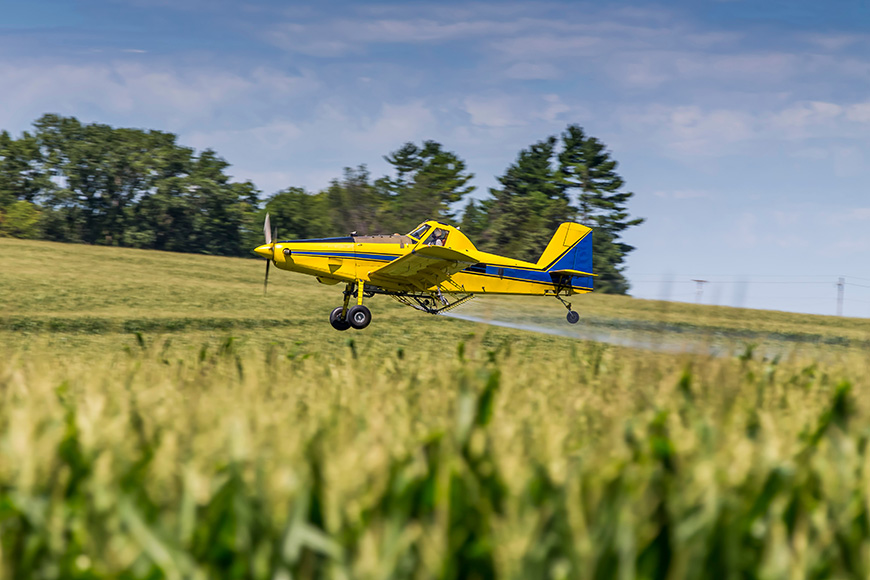Take Action Against Thrips in Cotton

During the hustle and bustle of planting season, it’s easy to overlook early-season pests that could cause season-long damage to your cotton crop. Thrips, in particular, require proactive management that starts at planting. Follow these actionable tips to protect your crop’s yield and quality potential.
After the crop has four to five true leaves, thrips become less of a production threat. That’s why focused early-season management efforts are critical for thrips control in cotton.
Wet, cool conditions increase thrips threats because plant growth is slowed, so the crop is more vulnerable to thrips injury for a longer period. Drought conditions may also favor higher thrips pressures because seed treatment uptake is reduced as soil moisture is limited. Therefore, the plant has less insecticide available in plant tissues, and pest control may not be as effective.
Consider growing conditions as you evaluate the risk for thrips pressure this season. North Carolina State University has a thrips pressure prediction tool that uses planting date, geographic location and local weather conditions to estimate thrips dispersal timing, seedling susceptibility and injury risk for most cotton-growing areas.
If you see primarily immature insects, the thrips population is growing, and an insecticide application may be warranted. There may be less urgency to pull the trigger on an insecticide application if you notice mostly adult thrips. If there are two or more thrips per plant up to the two-true leaf stage, I recommend a foliar insecticide application. As plants get larger, the economic threshold for application increases. In addition to counting insects, you should observe plants for typical thrips injury, including puckered or crinkled leaves.
There are several effective postemergence insecticide options for managing thrips. Bracket 97 contains the active ingredient acephate, a water-soluble insecticide that plant roots and foliage can readily absorb for systemic control of many feeding insects, including thrips. Radiant® SC and Intrepid Edge® are also effective postemergence insecticides for thrips control. Bidrin® 8 insecticide is highly effective against thrips but can negatively impact beneficial insect populations, so I recommend it as a last resort when thrips pressure is severe. Multiple foliar insecticide applications may be required to manage thrips in high-pressure situations effectively.
MAX-IN Ultra ZMB® micronutrient is a foliar-applied source of zinc, manganese and boron. Zinc is a catalyst for enzyme creation that aids in leaf growth and plant development. Manganese is essential for photosynthesis and plays a key role in resistance of plant diseases. Boron influences cell division and is essential as the plant begins to initiate squaring. Investing in early-season plant health is another way to protect against pest threats, as vigorous plants are more resilient against biotic stresses.
Thrips can be an overlooked insect in cotton, but the damage they cause can result in significant maturity delays and potential replant situations. It’s easier and more economical to proactively manage the insect with spray applications. Your trusted WinField United advisor can help you decide when you need to take action to protect your cotton crop.
All photos are either the property of WinField United or used with permission.
© 2022 WinField United. Important: Before use always read and follow label instructions. Crop performance is dependent on several factors many of which are beyond the control of WinField United, including without limitation, soil type, pest pressures, agronomic practices and weather conditions. Growers are encouraged to consider data from multiple locations, over multiple years and to be mindful of how such agronomic conditions could impact results. Armor, Bracket, MAX-IN, Ultra ZMB and WinField are trademarks of WinField United. All other trademarks are the property of their respective owners.
Understand The Threat
Thrips are piercing-sucking insects that punch a hole in foliar tissue and suck out cellular proteins causing leaves to pucker. They generally feed on young, vulnerable cotton plants, which weakens the crop and results in reduced stands, stunting and delayed maturity. Delayed maturity is especially consequential for northern cotton-growing areas, including Missouri, Arkansas, North Carolina and Tennessee, where the threat of frost requires timely harvest.After the crop has four to five true leaves, thrips become less of a production threat. That’s why focused early-season management efforts are critical for thrips control in cotton.
Consider The Growing Environment
As with most agronomic pests, thrips pressure varies from year to year and from field to field. This season, you may see higher thrips pressures due to an increase in wheat acres. Thrips require live plant material for feeding, so as wheat dries down in late spring, the insects migrate to newly planted cotton fields which serve as a host crop.Wet, cool conditions increase thrips threats because plant growth is slowed, so the crop is more vulnerable to thrips injury for a longer period. Drought conditions may also favor higher thrips pressures because seed treatment uptake is reduced as soil moisture is limited. Therefore, the plant has less insecticide available in plant tissues, and pest control may not be as effective.
Consider growing conditions as you evaluate the risk for thrips pressure this season. North Carolina State University has a thrips pressure prediction tool that uses planting date, geographic location and local weather conditions to estimate thrips dispersal timing, seedling susceptibility and injury risk for most cotton-growing areas.
Boost Scouting Efforts
Early scouting is critical for managing thrips in cotton. I recommend walking fields at emergence to begin gauging insect pressure. Gently bump or shake cotton plants onto a white background or bowl, and the tan-colored thrips will fall off for easy counting. It’s best to check 25 individual cotton plants per field to count the number of adult and immature thrips you see.If you see primarily immature insects, the thrips population is growing, and an insecticide application may be warranted. There may be less urgency to pull the trigger on an insecticide application if you notice mostly adult thrips. If there are two or more thrips per plant up to the two-true leaf stage, I recommend a foliar insecticide application. As plants get larger, the economic threshold for application increases. In addition to counting insects, you should observe plants for typical thrips injury, including puckered or crinkled leaves.
Take Multiple Crop Protection Approaches
Effective seed treatments are the first line of defense against thrips. Armor® cotton varieties are treated with either Acceleron® Standard or Acceleron® Elite seed treatments, which both include imidacloprid insecticide for thrips control. As the cotton seedling is germinating and emerging, the seed treatment is incorporated into the cotyledons and first true leaves. It protects the cotton plant against thrips for 14-20 days. If thrips pressure extends beyond the window of seed treatment control, postemergence insecticides may be necessary. In addition to seed treatments, in-furrow insecticides, including Bracket® 97, may add another layer of protection if planting equipment supports their use.There are several effective postemergence insecticide options for managing thrips. Bracket 97 contains the active ingredient acephate, a water-soluble insecticide that plant roots and foliage can readily absorb for systemic control of many feeding insects, including thrips. Radiant® SC and Intrepid Edge® are also effective postemergence insecticides for thrips control. Bidrin® 8 insecticide is highly effective against thrips but can negatively impact beneficial insect populations, so I recommend it as a last resort when thrips pressure is severe. Multiple foliar insecticide applications may be required to manage thrips in high-pressure situations effectively.
Add Efficiencies and Promote Crop Health
One way to boost the efficiency of insecticide applications for thrips is by tank mixing them with other applications. For example, adding nutrients, such as MAX-IN® micronutrients or plant growth regulators to the insecticide tank mix allows you to boost crop health and protect the cotton from harmful insects with one spray application.MAX-IN Ultra ZMB® micronutrient is a foliar-applied source of zinc, manganese and boron. Zinc is a catalyst for enzyme creation that aids in leaf growth and plant development. Manganese is essential for photosynthesis and plays a key role in resistance of plant diseases. Boron influences cell division and is essential as the plant begins to initiate squaring. Investing in early-season plant health is another way to protect against pest threats, as vigorous plants are more resilient against biotic stresses.
Thrips can be an overlooked insect in cotton, but the damage they cause can result in significant maturity delays and potential replant situations. It’s easier and more economical to proactively manage the insect with spray applications. Your trusted WinField United advisor can help you decide when you need to take action to protect your cotton crop.
All photos are either the property of WinField United or used with permission.
© 2022 WinField United. Important: Before use always read and follow label instructions. Crop performance is dependent on several factors many of which are beyond the control of WinField United, including without limitation, soil type, pest pressures, agronomic practices and weather conditions. Growers are encouraged to consider data from multiple locations, over multiple years and to be mindful of how such agronomic conditions could impact results. Armor, Bracket, MAX-IN, Ultra ZMB and WinField are trademarks of WinField United. All other trademarks are the property of their respective owners.





